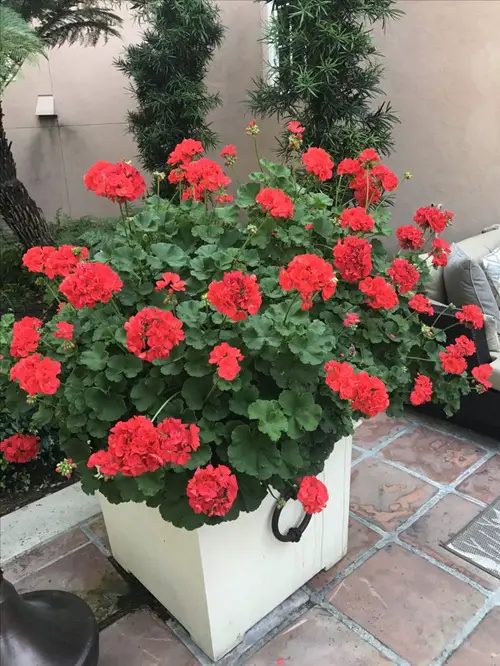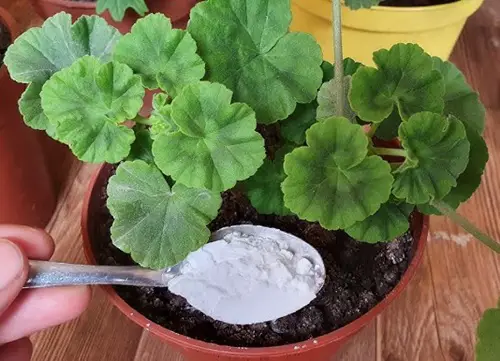Here is how baking soda can help your geraniums bloom more, allowing you to enjoy a colorful display in the garden and at home.
Geraniums are loved for their blooms and ease of care, but sometimes they need a little push to flower more profusely. Surprisingly, a common kitchen ingredient like baking soda can make a noticeable difference. Here’s how using baking soda on geraniums can help you get more flowers!
How Baking Soda Helps Geraniums Flower More
Baking soda or sodium bicarbonate slightly raises soil pH, making it more alkaline. And geraniums are among the few flowering plants that actually prefer neutral to slightly alkaline soil (ideal pH is 6.5–7.5), which means more blooms!
Over time, garden soil can turn acidic, especially after heavy rainfall, overfertilization, or mulching with acidic compost. In acidic conditions, phosphorus (the nutrient responsible for bud formation) gets “locked” in the soil and becomes inaccessible to the plant.
What’s fascinating is that even a small pH nudge from baking soda can temporarily “unlock” phosphorus, improving root energy and flower output. But that’s not all:
- Baking soda can also help reduce fungal spore germination, which is why it’s used in organic fungicide recipes. It can also act as a preventative shield for geraniums prone to powdery mildew or botrytis.
- Some gardeners also say that baking soda helps neutralize slight salt buildup in potting mixes, which can otherwise interfere with nutrient absorption, particularly in container plants.
Note: This temporary fix lasts about 5–10 days, depending on your soil type and watering frequency. You’ll still need stabilizing agents like dolomite lime or crushed eggshells in your soil mix for long-term pH control.
Using Baking Soda For Geraniums For More Flowers
Mix 1 teaspoon of baking soda into 1 liter (approx. 4 cups) of water. Stir until fully dissolved, then pour it directly into the soil around the root zone, avoiding the stems and leaves. Apply once every 10–14 days during the active blooming season (late spring to early fall). Easy, right?
Pro Tip: Before applying, pre-water your plant if the soil is dry; this avoids root shock and helps the solution absorb more evenly.
For potted geraniums, make sure your container has adequate drainage.
Baking soda plus soggy soil is a recipe for root rot or nutrient lockout. If you already use chemical fertilizers, try this method on just one or two plants first to see how they respond.
Bonus Use: Spray to Prevent Fungal Issues
If your geraniums are struggling with mildew, fungal leaf spots, or humid conditions, baking soda can also work as a DIY foliar spray. You’ll need:
- 1/4 teaspoon baking soda
- 1 liter of water
- Add 2–3 drops of mild liquid soap to help it stick to leaves
Spray this in the early morning, focusing on the underside of the leaves, which is where fungal spores often thrive. Avoid misting during midday or evening. Sunlight and baking soda can cause leaf scorch, and nighttime application can invite moisture buildup.
When To Use Baking Soda
The ideal time to use baking soda on geraniums is during their active growing and blooming periods, from late spring through summer. This is when the plants form buds and need consistent access to nutrients and perfect soil conditions. It works exceptionally well if:
- Your geraniums are growing in cocopeat-heavy potting mixes (you can also use composted bark, perlite, vermiculite, or even coarse sand)
- The plants are forming lots of foliage but few flowers
- You’re in a humid or coastal area where fungal issues flare up quickly
Soil Hack: You can test soil pH with a $1 pH strip kit or even red cabbage water; if the water turns pink, it’s acidic; if it turns green-blue, you’re in the geranium-safe zone.
A Few Don’ts to Keep in Mind
- Don’t mix with vinegar-based sprays or acidic fertilizers–you’ll cancel out the pH effects.
- Don’t treat plants in shared pots with acid-loving neighbors like begonias or impatiens; they may suffer.
- Don’t rely on this as a primary fertilizer. Baking soda doesn’t supply nutrients; it only adjusts conditions for nutrient uptake.
So what are you waiting for? This simple solution, combined with good sunlight, moderate feeding, and deadheading, can help you have a longer, brighter, more reliable bloom season. Try it today!





